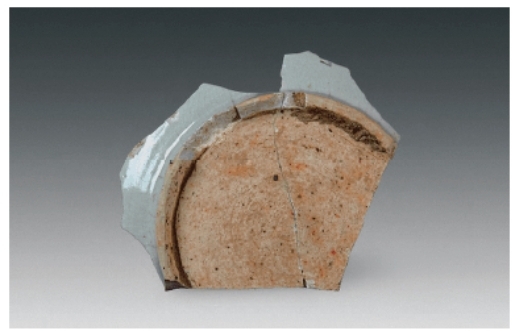
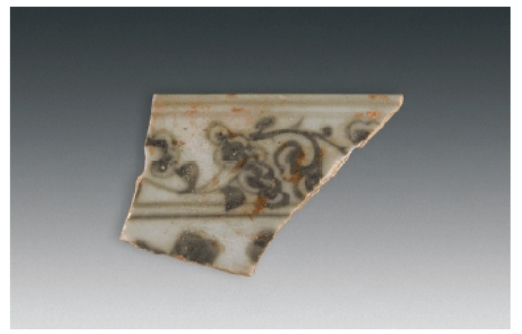
Early Ming Folk kiln blue and white Revisit
In the Chinese academic circle, Early Ming Hongwu/Xuande folk kiln blue and white is still a controversial topic and there is clear divergence in view between the Nanjing and Jingdezhen researchers. In 1964, Wang Zhimin (王志敏) of Nanjing museum pioneered a project on identification of early Ming blue and white. He collected tens of thousands ceramic shards from the Yudai river where the old Nanjing palace was built by the founding emperor Hongwu and remained its capital till Emperor Yongle relocated the capital to Beijing in 1421 A.D. Based on stylistic comparison, he was able to form some meaningful deductions on characteristics associated with Hongwu/Xuande and later dynastic Ming period. The prominent Bejing Palace museum expert Geng Baochang in his book “明清瓷器鉴定” also confirmed the existence of folk kiln Hongwu/Xuande blue and white wares. In contrast, the Jingdezhen researchers argued their case base on archaeological Kiln and graves findings. So far from dated excavated graves, there were no folk kiln blue and white earlier than Zhengtong Period. According to Professor Ouyang, those excavated graves from Xuande and earlier consisted of mainly white wares.
The excavation of Jingdezhen Luo Maoqiao site (景德镇落马桥窑址) in 2012 revealed that it commenced production from 5 Dynasties period and continuously produced ceramics till late Qing period. The Jingdezhen archaeologists paid particular attention to the early Ming Hongwu/Xuande stratigraphical layer. The fragments recovered were small in number and variety limited. The majority were white glaze bowls/plates (2966 pieces which constituted 97.8% of the finds) and small number of overglaze red/green and underglaze red wares. There were small number of jars, stem cups and building architectural parts. In contrast, at the interregnum period (Zhengtong - Jingtai - Tianshun) layer, out of the 8498 fragments recovered, 6031 (71%) were blue and white. There were 2067 (24.3%) white glaze fragments and small number of green and brown glaze fragments.
 |
 |
| Luo Maqiao kiln White glaze fragment | Luo Maqiao kiln underglaze red fragment |
Li Yang (丽阳窑) kiln located 21km southwest of Jingdezhen was discoverd in 2005 and the kiln blue and white finds were generally attributed to the Interregnum period but the possibility of some being late Xuande was not ruled out. The gourd shaped kiln provided useful clues to the dating of the site. It revealed physical characteristics which suggested has evolved from Jingdezhen imperial Hongwu/Yongle and was the missing link to Mid Ming Hutian gourd shaped kiln.
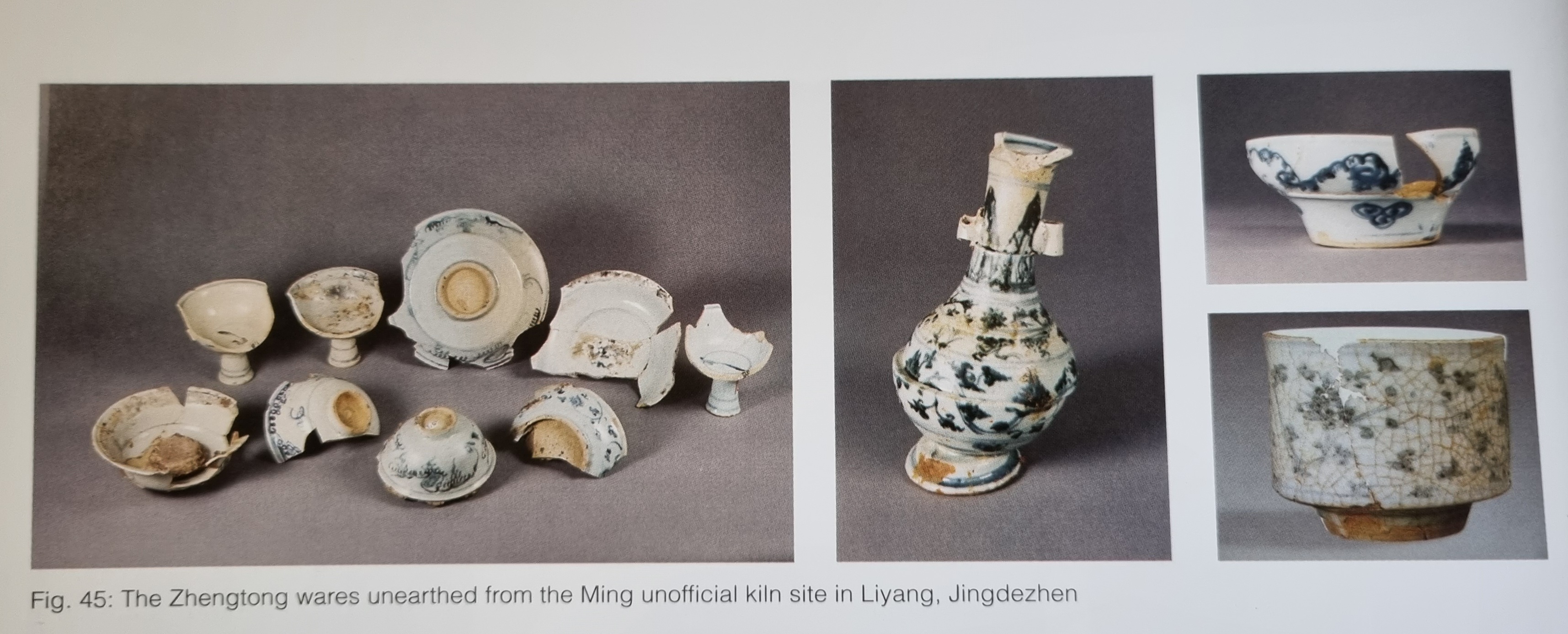 |
|
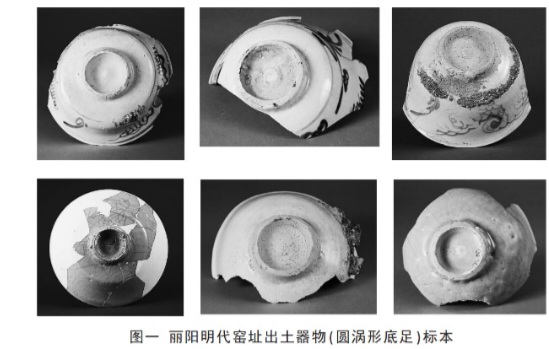 |
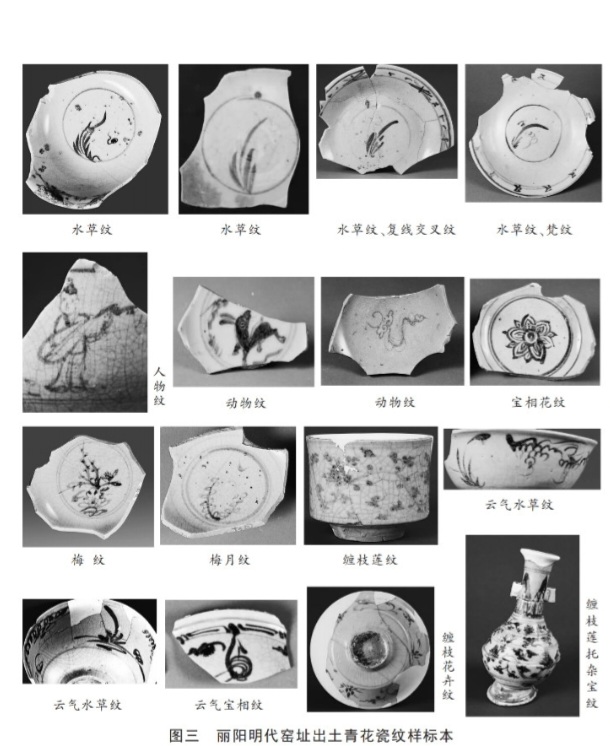 |
| Ming blue and white fragments recovered from the Li Yang kiln site | |
It is interesting to note that the foot of large number
of bowls from the Li Yang site is thickly potted. The outer foot wall of the
bowl is tilted inward and the outer base curves inward with a rounded protrusion
at the centre.
| Comparison of the foot of Yuan Blue and white (at the back), Hongwu white glaze and an early Ming (probably Yongle/Xuande) Blue and white bowl. All have the thick foot wall and unglaze base. The Yuan version has a square cut foot, which during the Hongwu period has both the interior and exterior edge shaved inward to a V shape. The central protrusion is retained on all the 3 versions. |
In fact, such a foot treatment is also found on white bowls from a grave dated to 5th year of Yongle (1407 A.D ) as mentioned in Geng Baochang's book. In contrast, those from Luo Maqiao kiln has thinner foot wall and glazed flat outer base. Interestingly, such bowls with sketchy floral spray or fu/shou character chinese character on the interior and floral scroll or scrolling cloud some with human figure on the exterior, were found in relatively large number in Guangxi Guilin. They were attributed to Hongwu period by the Chinese archaeologist Li Hua in his article on the study of Hongwu folk kiln blue and white. Is there the likelihood that some of the Li Yang Blue and white wares were earlier, perhaps Yongle if not Hongwu?
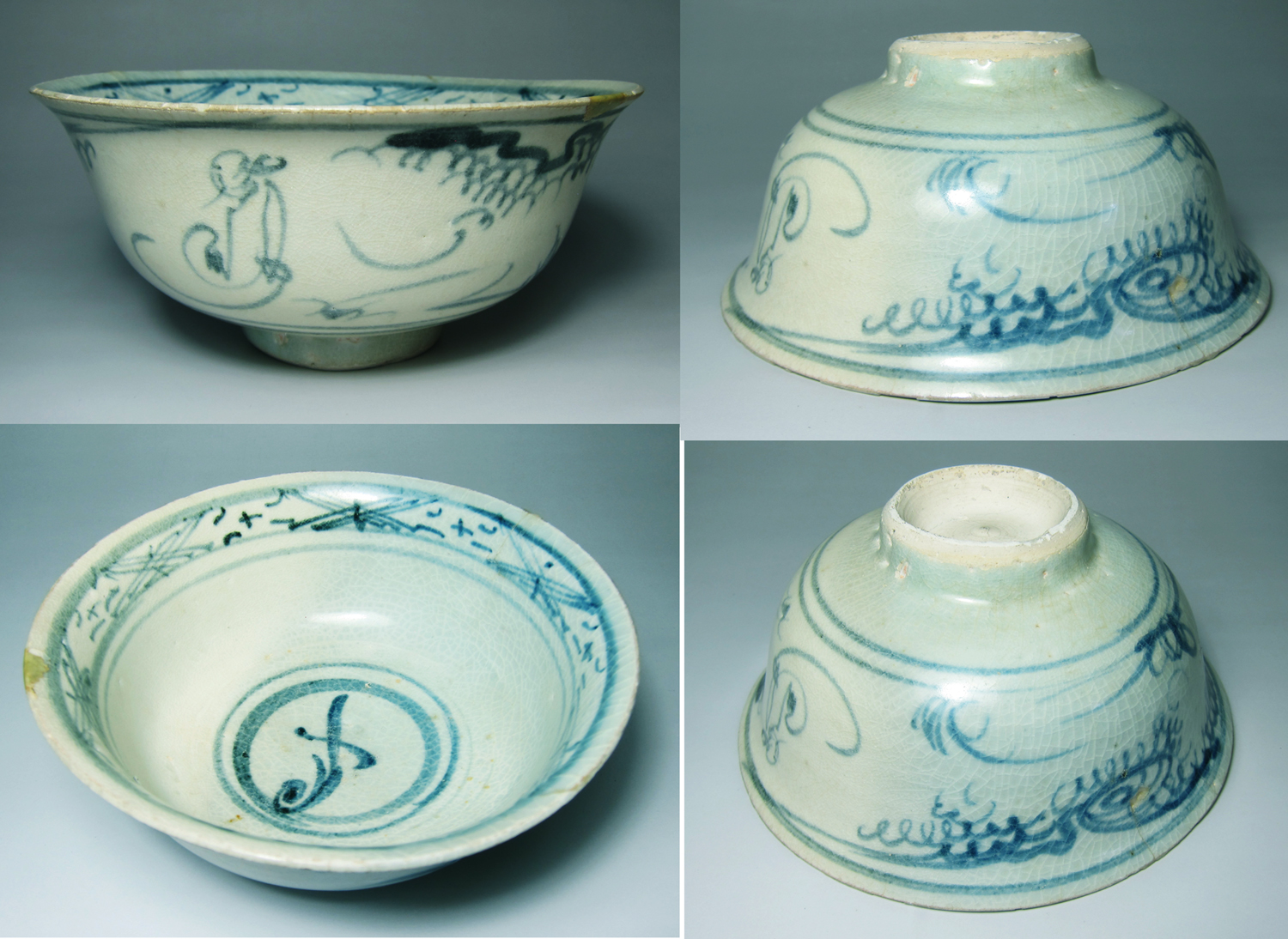 |
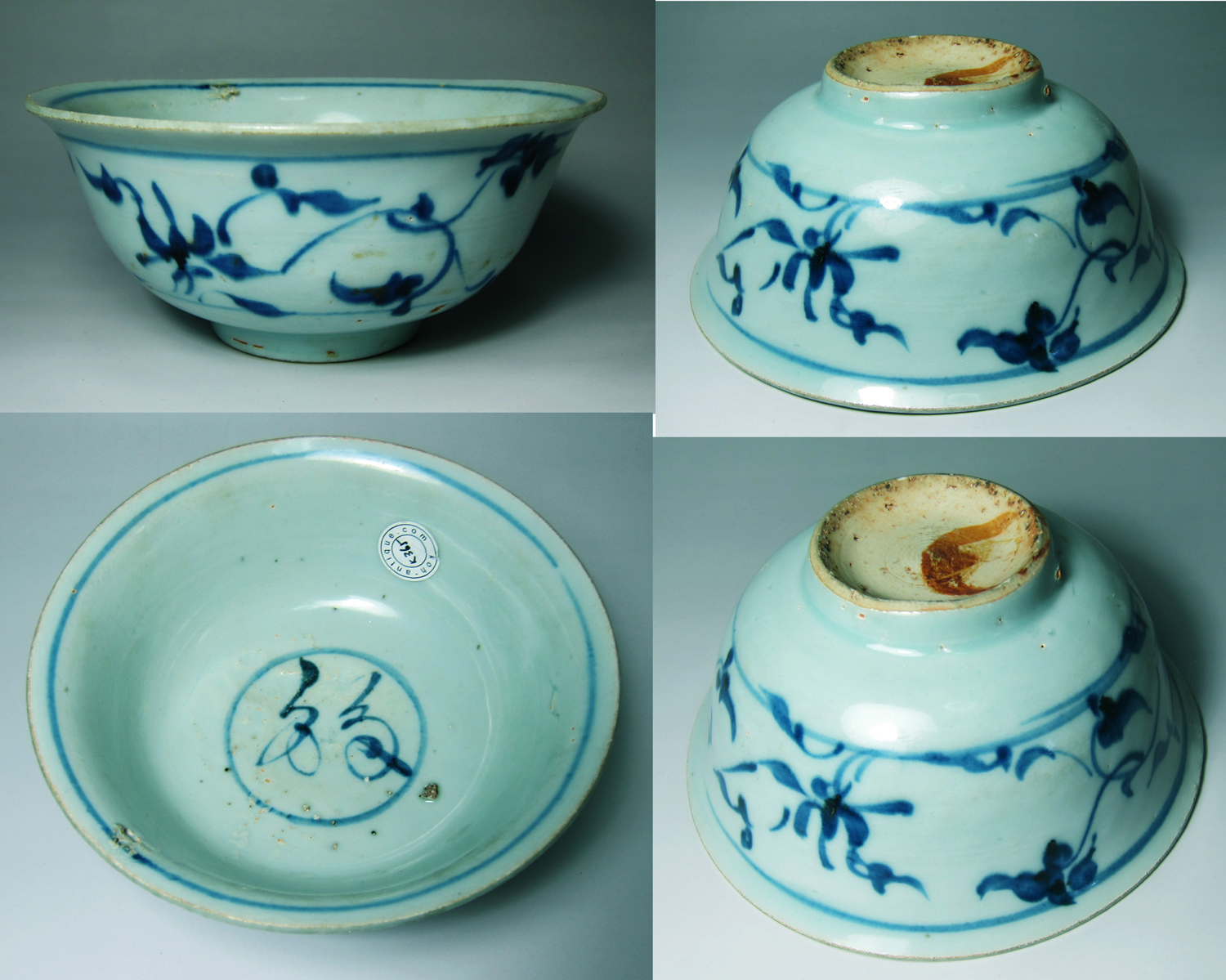 |
| Three examples similar to those found in Li Yang kiln |
A Beijing collector has in his possession a piece of broken blue and white bowl with Ming Xuande Year (明宣德年) written on the interior. It was found in a Beijing ancient habitation site. It also has the simple floral scroll and the thick unglaze foot with central protrusion. Hence, it is a characteristic that has persisted and still found during the reign of Xuande. From the perspective of ancient ceramic production, it is quite a short span of time of around 40 years from closing years of Hongwu to Xuande period.
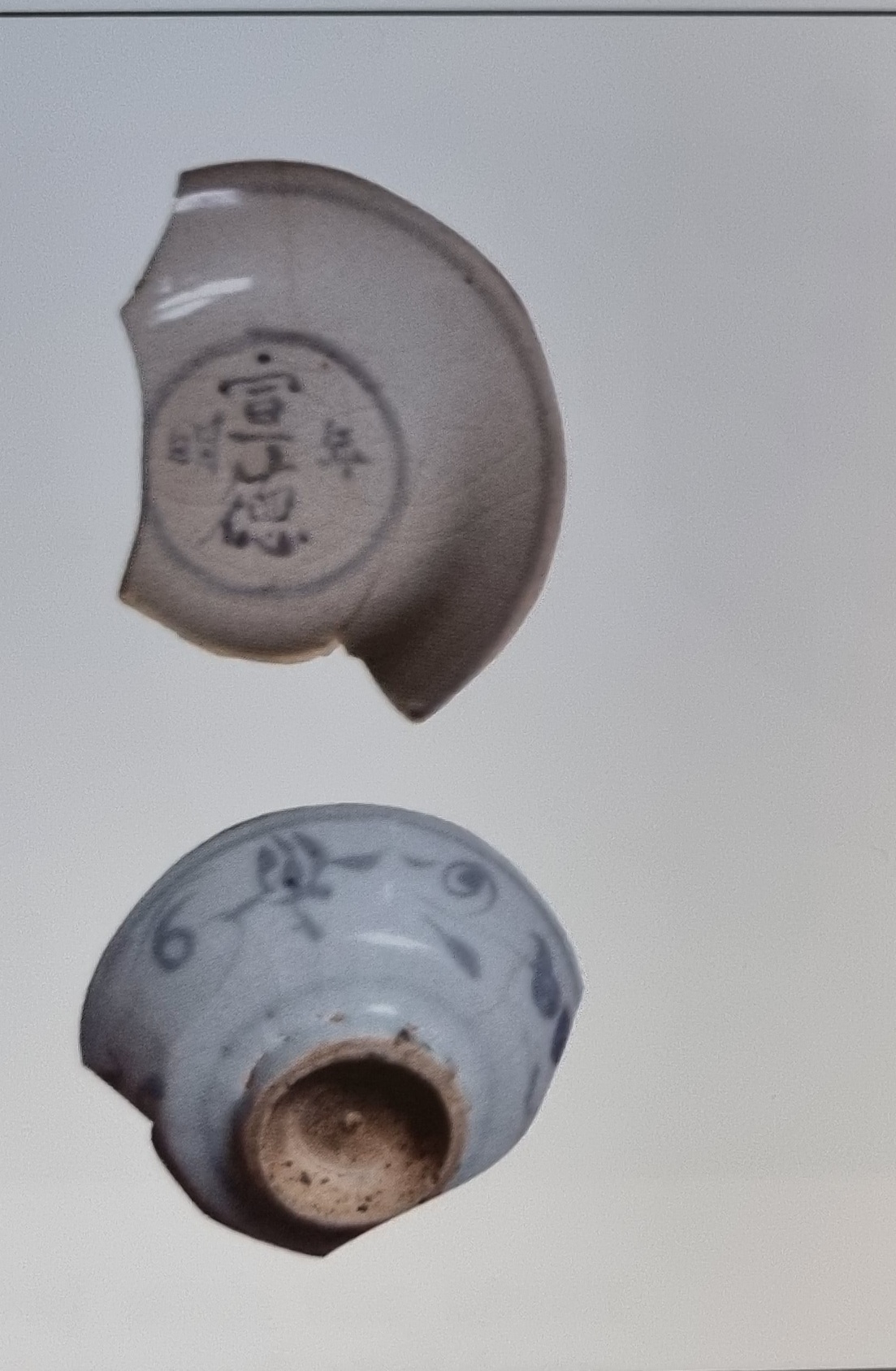 |
| Bowl with Ming Xuande Year mark (From Beijing Collector Qu Yong Jian in his book “北京出土瓷片断代与鉴赏” |
Personally, I think during the Hongwu period, it is possibly there was little if any blue and white being produced. Ming blue and white entered its golden phase during the Yongle/Xuande period facilitated by availability of imported cobalt brought back by Admiral Zhenghe from his overseas trips. The popularity of imperial blue and white might have influenced the folk kiln potters to introduce such products on a small scale during the Yongle reign. But the acceptance by the common folks was slow. The quantity likely gradually increased during the Xuande period but plain white glaze wares still predominated and preferred by the common folks.
According to Prof. Ouyang Shibin, some tests revealed that Yuan blue and white, even those which appeared greyish and commonly found on the lower end pieces, used imported cobalt. If indeed all Yuan Blue and white were painted using imported cobalt, then cobalt supply during Ming Hongwu period would pose a problem as foreign contacts and trade were forbidden. The remaining stock of cobalt acquired during the Yuan period would be scarce and precious. Hence, not surprisingly they were used only for the imperial wares. In fact, during the Hongwu period, copper red and iron red pieces were also produced in considerable quantity to meet the need of the palace. The supply of imported cobalt would have resumed in Yongle period and possibly brought back by the fleets of Admiral Zhenghe whose maritime trips reached as far as East Africa.
During the early Ming period, a relatively high degree of control was imposed on political and cultural development. For eg. during the reign of Hongwu, a decree was issued in the year 1371 which forbid certain subjects such as previous emperors, queens, sages or saints, dragon, phoenix, lion and chilin on porcelains. During the Hongwu period, there were many instances of capital punishment for infringement of the policies. To quote an example, an artist named Sheng Zhu was executed because he painted the drawing of a celestial being riding a dragon. That was deemed a grave crime as the dragon is associated with the emperor.
Yuan blue and white was mainly an export oriented product. According to the early Ming commentary Ge Gu Yao Lun (格古要论) by Cao Zhao (曹昭), blue and white and over-glaze enamelled wares were considered aesthetically distasteful. With the Hongwu ban on export and the lack of interest in domestic market, the incentive to continue production is likely low and may have ceased for a prolonged period. The fact that white/qingbai glaze vessels were found in excavated burial sites dated to Hongwu/Xuande substantiated the preferences of the common folks.
In the 1980s, the Li Shu Tan (栗树滩) kiln site in Yaoli (瑶里)was surveyed. Unfortunately, no effort was made to protect and preserved the site. It was subsequently also destroyed by development. Prof. Ouyang Shibin (欧阳世斌) and Mr Huang Yun Peng (黄云鹏) from Jingdezhen were among the few who have studied the site. According to their lecture notes, there was clear stratified layers. Above the layer of Yuan qingbai wares with unglazed rim, there was a layer of white /qingbai glaze dishes with angular wall and bowls with everted rim. According to Huang, this layer is dated to early Hongwu period. Above this layer, there were blue and white bowls with simple cloud, floral scroll, butterfly, Fu character in running style and etc. The ceramics remains from this layer were from the late Hongwu to Xuande period. The dishes and bowls all have an unglazed ring on the inner base. It should be noted that those from Yaoli were mainly low quality ceramics products.
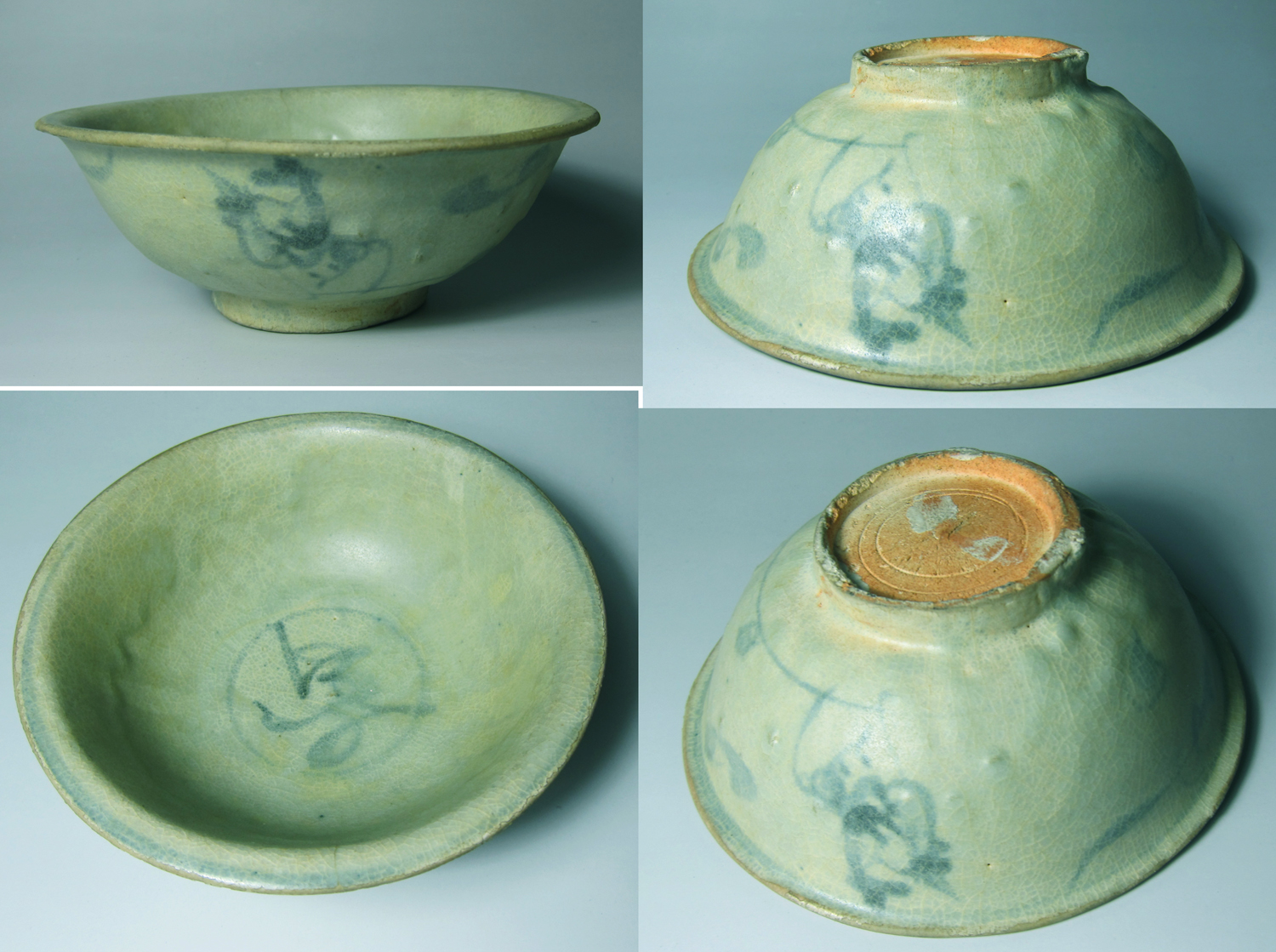 |
| Blue and white bowl with running script shou on interior. The short footring oxidised to an orangy colour tone is rather similar to those white ware found in Luo Maoqiao Hongwu/Xuande stratigrahic layer. |
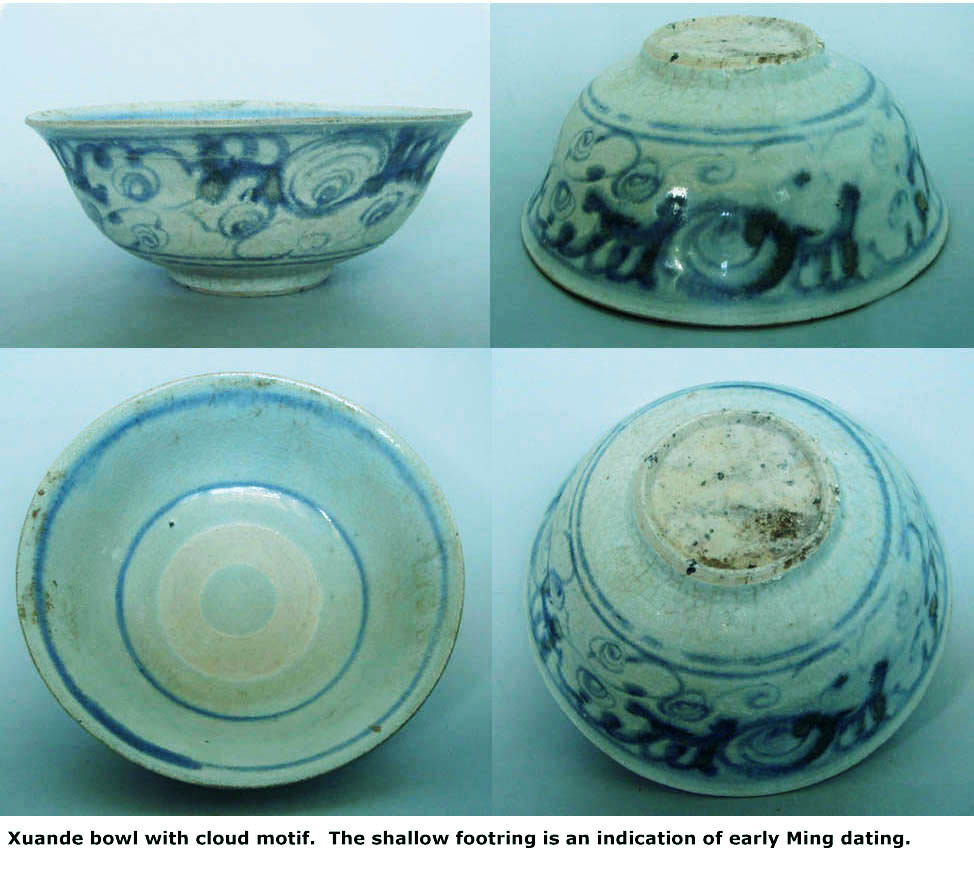 |
| This example could be similar to that type mentioned in the Yaoli Li Shu Tan kiln site |
If we examine motifs commonly attributed to Hongwu folk kiln blue and white, they consisted of simplified floral spray, floral scrolls, floral scrolls with sanskrit/tibetan character or buddhist precious objects, scrolling cloud motif sometime wih scholar , embroidered balls with ribbons, ful/shou characters and etc. Stylistically, the motifs appear to be influenced more by the imperial blue and white from Yongle/Xuande period. The potters from folk kilns copied the motifs but disregarded the details , simplified and executed them using calligraphic strokes.
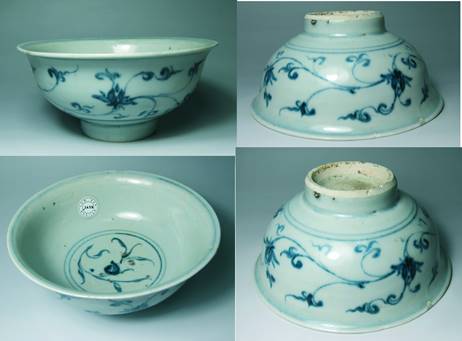 |
| This blue and white bowl with
peach motif on the interior is dated by Prof. Zhang Pusheng, an expert
on Ming blue and white and a student of Nanjing Wang Zhi Min, to
Yongle period. It has a thick foot with central protrusion and the
sugary white glaze is reminiscent of Yongle Tianbai. |
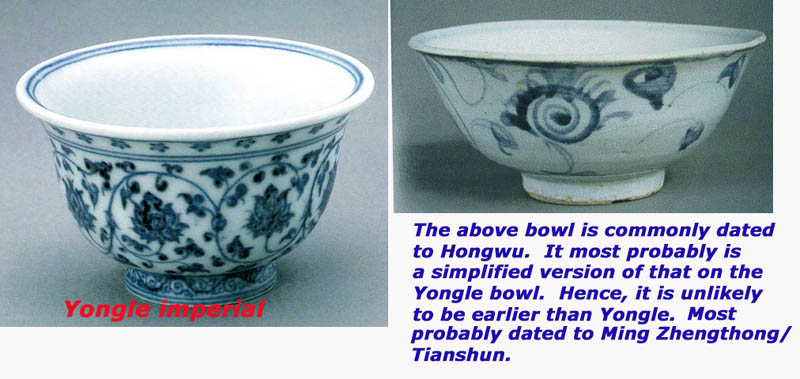

It is also necessary to ascertain when and where Jingdezhen potters found the source of local cobalt for blue and white production. From the series of tests done on Xuande imperial blue and white pieces, it is now certain that at least some also used local cobalt for part of the decoration. But it does not give any clue on whether the local cobalt was first used by imperial kiln or folk kilns. But what is certain is that the availability of local cobalt at least by Xuande period would enable folk kilns to produce blue and white wares. Yunnan blue and white which used local cobalt likely commenced production during the Hongwu/Yongle period. We cannot rule out the possibility that Yunnan might be the initial source for the cobalt.
In conclusion, Early Ming Hongwu/Xuande production is still very much a controversial topic shroulded in mystery. I have furnished some of the latest available archaeological information from Chinese sources which are relevant for the discussion and highlighted the various issues that need to be explored and resolved. Hopefully, in the near future more archaeological findings and excavations will offer sufficient solid scientific evidence to put to rest the controversy.
|
By NK Koh (25 Sep 2008), updated: 24 May 2022 |